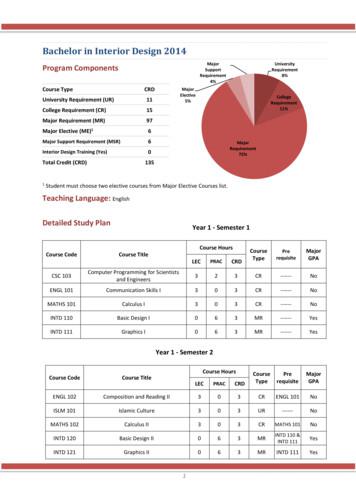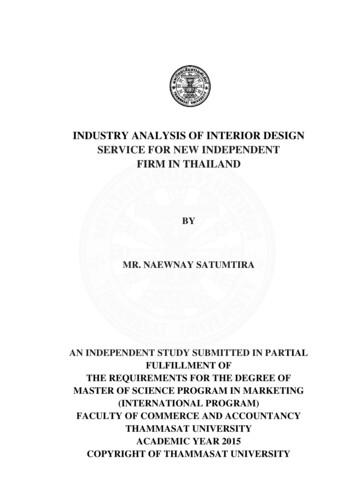Interior Design INFO
interior design INFOspring 2009Evidence-based approach keeps Uahead of the curve By Suzy FrischWhen an interior designer tackles a project, practitioners often don’t have the time orresources to pore over journal articles about gender restroom discrimination or theinfluence of ergonomics on workers’ productivity. But they can turn to InformeDesign , anonline searchable database of the latest research on design and human behavior.Two interior design professors in the College of Design are the co-creators ofInformeDesign, which was funded by the American Society of Interior Designers. It aimsto help professionals use current research to inform their design decisions, a conceptcalled evidence-based design. Simultaneously, the site serves as a tool for the University’sinterior design program to teach students how to engage in evidence-based design whilebalancing it with creativity.As evidence-based design emerged as a compelling trend in the past decade, the U’sinterior design program stayed ahead of the curve by integrating this approach andInformeDesign into its curriculum. Starting in their earliest studios, interior design studentslearn how to take an evidence-based approach to their projects. And by the time theygraduate, students are well-versed in the practice, said Professor Denise Guerin, Ph.D.,who developed InformeDesign with Assistant Professor Caren Martin, Ph.D.This is just one example of how the interior design program keeps up on industrytrends and incorporates them into its evolving curriculum, noted Guerin, Morse-AlumniDistinguished Professor and interior design program director. “We’re not just addressingwhat’s happening in today’s profession,” she said. “We’re also forecasting where practiceis headed so that by the time students become alumni, they are able to work in ways thatwill contribute to a firm’s growth and development.”Other curriculum additions to the interior design program include sustainable design andthe relationship of culture and design. Professors introduce sustainability in students’sophomore-level studios, and this concept gets included in most subsequent courses.In fact, spring 2009 students can take an elective course that prepares them for theLeadership in Energy and Environmental Design (LEEDTM) commercial interiors exam.Due to the globalization of design, another studio focuses on developing cultural identityin the residential environment, encouraging student designers to consider the social andpsychological needs of multi-cultural occupants. “It’s not just about international culture,”Guerin says. “We’re teaching a method by which students can gain a deep understandingof the occupants and their needs in any environment.”The interior design program’s advisory board is a critical element in its success at stayingon the leading edge. Composed of 12 interior designers, architects, project managers, andmanufacturers’ representatives, the board meets twice a year to discuss industry needs,technologies, and future forecasts. In addition, the board helps evaluate the program’sstrengths and areas to improve. Members have their pulse on the profession, serving asan invaluable resource that keeps the interior design program on the right track.Welcome to interiordesign Info, anewsletter bringing youup to date. This issuefeatures an updateon the interior designprogram, a quickview of key faculty,interviews with “justgraduated” studentsand practitioners turnedgraduate students. You’llget a great view of whatwe are all about—now!Please send your e-mailaddress to dhainfo@umn.edu for future issues!
zanski’s interior design workKaiser’s interior design workRecent grad Mandi Zanski advises students toconverse, observe, interact By Lori-Anne � Theseare the words ofadvice that freshlyminted interior designgraduate MandiZanski delivered toincoming Universityfreshmen at the fall 2008 convocation.She was selected as a convocationspeaker because of her strong academicrecord, as well as the enthusiastic way sheapproached her education.“I had amazing experiences,” Zanskisays, looking back. In her freshmanyear, she traveled with Professor BradHokanson and other students to BuenosAires, where she visited a variety ofgraphic design firms over two weeks. Thefollowing summer, she focused on thehistory of design and architecture whilestudying in London, Paris, and Florencewith Associate Professor StephanieZollinger, Ed.D.Academic Excellence at the end of her DISstudies. Zanski may one day return to DISas an intern to obtain experience in theinternational workplace.Back in Minnesota, Zanski never stoppedworking. As her honors capstone project,she worked with Denise Guerin, Ph.D. andwrote an InformeDesign issue of Inquiry,a research brief on culturally sensitivedesign. She approached the project first bycompleting an exhaustive literature search,then crafting what she terms “culturallysensitive design for beginners,” a firststep to understanding the complexities ofworking outside of one’s own culture.Zanski also took full advantage of hersenior thesis project as well. With a teamof students, she researched healthcaredesign. In the first semester, the teamlearned about healthcare design forchildren by interviewing doctors and otherpractitioners, visiting clinics across the TwinCities, and completing a comprehensivedesign program. The following semestershe designed a pediatric clinic—goingthrough the phases of schematic design,design development, constructiondocuments, and final 3-D representations.Zanski also found time to complete aninternship with Studio Hive, Inc., whereshe had an opportunity to work on aproject at the new TCF Bank Stadium. Theinternship led to a job offer at Studio Hivefollowing graduation.With such a variety of experiences, Zanskiwas a natural choice as the freshmanconvocation speaker last fall. She gavethe new students simple advice thatserved her well during her years in theCollege of Design: converse with eachother, observe the professionals, andinteract with your professors.Zanski also spent six months inCopenhagen, studying at Danish Institutefor Study Abroad (DIS). Although interiordesign students were in the minorityin the program, Zanski was awardedthe Architecture and Design Award forScholarships Make a DifferenceThe Interior Design program isfocused on creating privately fundedscholarships funds to help students meetthe rising costs of higher education. TheUniversity is offering a rare opportunityto double the impact of gifts throughthe Promise of Tomorrow Scholarshipdrive. Gifts of 25,000 or more areinterior design, Spring 2009used to create an endowment fund at theUniversity of Minnesota Foundation andthe payout from the fund is matched by theUniversity, thereby doubling the impact ofthe gift. A group of interior design alumniis currently meeting to make a plan fordeveloping at least one of these matchingscholarships. Alumni and friends can helpSummer internship turns into full-time job forKatie Kaiser By Suzy FrischKatie Kaiserpacked in alot of learning,traveling,leading, andwork experienceduring her fouryears as aninterior designundergraduate.And it all paid off when she turned aninternship into a full-time job at the Bostonarea firm Sasaki Associates.She couldn’t be happier at Sasaki, aninterdisciplinary design firm with its handin architecture, urban planning, landscapearchitecture, graphic design, interior design,and eco-technologies. Kaiser credits herstretch at the University with preparing herfully for her first professional job.“There are many opportunities at the U,and I loved being in Minneapolis becauseit’s a great place for design,” says Kaiser.“Everything I learned I’m seeing myselfapply in the field. My education definitelyprepared me for different scenarios.”Kaiser, a native of Altoona, Wisconsin,started at Sasaki as a summer intern witha cohort of 12 other students from acrossthe country. Unlike the other interns whohad to return for their senior year, she hadrecently earned her bachelor’s degreein interior design from the University ofMinnesota. So Sasaki kept Kaiser onthrough the fall and then extended her ajob offer at the end of last year.Kaiser took full advantage of many ofthose opportunities, including two studyabroad trips to Argentina and Europe,several internships, the Honors Program,and a capstone project. She also servedon the student and alumni board for theCollege of Design and participated in theAmerican Society for Interior Designersstudent chapter.During her time at Sasaki, Kaiser hasbeen designing the interior of a largecorporate office in a nearby Boston suburb.Kaiser says she learned a lot from hercapstone project, which got her involvedwith the Minnesota Interior DesignLegislative Action Committee. Throughthis organization she helped lobby fora practice act in Minnesota that wouldregulate who can practice licensedinterior design.Her many internships—including stintsat Target Corporation, Wells Fargo,RSP Architects, and a residential firmin her hometown—exposed Kaiser tohow designers work in the real world.They also gave her a close-up viewof different work environments andspecialties, including corporate, inhouse retail, and residential interiors.“Being in an office is a great learningexperience. You learn so much that youdon’t necessarily get in the classroom,”she says. “I think it’s great that theU supports internships. I don’t thinkI would be a successful designer if Ihadn’t had them.”Kaiser plans to continue exploringinterior design, eventually going back toschool for an advanced degree. She’swell on her way to a promising future.What if healthcare facilities could prevent injury and disease?by making gifts directed to scholarshipsfor interior design students that can thenbe added to this endowment.Increasingly, evidence-based healthcare environments are designed to promote healing and reduce stress. Health sciences andenvironmental health research also points to ways in which infection, illness, and injury can be prevented through good design.Check out these Research Summaries on InformeDesign!For more information, contact Jan Sickbertat 612-624-3283 or sickb001@umn.edu,or visit the U of M Foundation’s Web siteat: www.giving.umn.edu.Natural Sights and Sounds Reduce Medical Procedure Painhttp://www.informedesign.umn.edu/Rs detail.aspx?rsId 2506Controlling Daylight for People with Alzheimer’s Diseasehttp://www.informedesign.umn.edu/Rs detail.aspx?rsId 2058Promoting Healing in Health Environmentshttp://www.informedesign.umn.edu/Rs detail.aspx?rsId 2178Patient Outcomes in a Surgical Intensive Care Unithttp://www.informedesign.umn.edu/Rs detail.aspx?rsId 20162interior design Spring 20093
LiveWell backShoppeEvolving nature of the field leads two practitionersto schoolStefnee Trzpuc and Kari Ihle have thekind of career trajectories every buddinginterior designer dreams of. Each foundgood jobs with respected firms straightout of college and quickly took onascending responsibilities. They findtheir work fulfilling, and they continue tolearn on the job. Yet both have chosento return to school for a master’s degree.The evolving nature of the field led themspecifically to the vanguard work beingdone at the College of Design’s interiordesign program.Stefnee Trzpuc’s path from North DakotaState University led her to an internshipwith BWBR Architects in St. Paul, whichThis 6000sf store is focused on2007, while continuing to work at BWBR.helpingmakethethechoiceShepeoplewill completemasterof scienceto liveprogramtheir liveshealthy,in abouta year. smartand inspired. A myriad ofShe’s already started implementing whatunique solutions for theseshe’s learning into her work, and hashealthychoicesis displayedin an atstarteddevelopinga new programenvironmentdesignedBWBR that will integrate evidence-basedspecificallyfor allHenryFordmajorWestdesign intothe firm’smarkets.Evidence-based design can encompass Bloomfield Hospital and is inTrzpuc considered other schools, buteverything from environmental psychologyconcertwith their overall dÈcorchose CDes because of its emphasis onto physiology, for instance, from whatthemeandtarget customer.evidence-baseddesign, which she said, isin turn led to a job after she earned herdegree in 2002. LEED AP and a certifiedinterior designer, she began with a focuson retail hospitality projects, but grewinterested in the healthcare projects shehas worked on while at BWBR. Throughthat work, she has also become moreinvolved in evidence-based design.drains mental energy to how many mileshospital nurses walk per day. It’s alsoan increasingly important factor in theindustry, Trzpuc said, and the primaryreason she returned to school full-time inStefnee Trzpuc; photos courtesy of BWBR Architects.Stefnee trzpuc, CID, Leed Apinterior design, Spring 2009“more than just a trend. It’s a new way ofdoingthings.” She’salso enthused aboutProductcategoriesincludethe home,interior designfaculty.healthycookingfor “It’slife,exciting towork with instructors who challenge mebody-mind-spirit, fitness,and are enthusiastic about the directionnutritionalsupplements, healthyI’m taking,” Trzpuc said. She’s also plants“Working withand florals,personalcare,students really bringsbackgiftsexcitement ofdesign; it’s made me a better practitioner.”and more.The opportunity to teach was a big drawIntegratedandfor Kari withIhle asthewell.organicIhle is oneof the luckysustainablethemeofthepeople who knew from an early age whathospital,productlinesareshe wantedto doprofessionally.“I alwayslikedonrearrangingmy room,and aboutfocusedthose thatare 100%oncea monthI’d makemy mom help me.naturalandorganic.FutureWe started watching Designing Womenplans include additionaltogether [a 1980s TV show about a womenì condition-stateîthemes(picsreally excitedowned design firm]and I wasshowwhenOncologyCareandI found out you could actually haveWomenísHealth)physiciana job doingwhatandI likedto do. Little did Iknow how different interior design is!”features.After graduating from Iowa State in 1999,she moved to the Twin Cities. Beforeestablishing her own consulting business inretail design, she worked at HGA Architectsand Engineers, primarily on healthcareprojects; ATS & R Planners/Architects/Engineers on K-12 school facilities; and eqlife, a former retail chain aimed at womenconsumers, designing traditional retail andhealthcare retail projects.4This 6000 sf store is focused onhelping people make the choiceto live their lives healthy, smartand inspired. A myriad ofunique solutions for thesehealthy choices is displayed in anenvironment designedspecifically for Henry Ford WestBloomfield Hospital and is inconcert with their overall dÈcortheme and target customer.This professional experience actuallyrekindled her desire to teach. An invitationto speak before a beginning design classat the University reminded her just howmuch she loved working with students andcemented her decision to return. Anotherreason is her desire—indeed, the need—tostay on top of new developments in thefield, particularly evidence-based design.“The University of Minnesota really teachesyou how to do your own research, tounderstand the research out there, andread it and apply it,” Ihle said.She’s also minoring in sustainable design,and plans to become a LEED AP thissummer, an extra boost for her career.Although eventually she plans to earn aPh.D., for the time being, she wants tocontinue her consulting business, not onlyfor practical reasons but because it willhelp her stay relevant as she pursues herultimate goal, to teach.Like Trzpuc, Ihle sees teaching as a twoway street, whether the students know it ornot. “Their passion gives me more passionfor my career. I don’t think they even realizehow much they give to us.”What if workplaceProduct categories includehealthy home, cooking for life,body-mind-spirit, fitness,nutritional supplements, healthysnacks and drinks, fresh plantsand florals, personal care, giftsand more.Ihle’s interior design workIntegrated with the organic andsustainable theme of thehospital, product lines arefocused on those that are 100%natural and organic. Futureplans include additionalì condition-stateî themes (picsshow Oncology Care andWomenís Health) and physicianfeatures.lightingcould improve workerHenry Ford Retail photos.By Judy ArginteanuPhoto by Jeanne SchachtLiveWell Shoppeperformance?Does “workplace lighting” conjure images of flickering fluorescent? It shouldn’t. Research increasingly suggests lighting systemsdesigned to optimize use of natural daylight and respond to users’ tasks and preferences can result in energy savings, better workerproductivity and mood, improved communication, and even better sleep. Sound appealing?For more information visit InformeDesign atwww.informedesign.umn.eduDaylighting in Double-Skinned Buildingshttp://www.informedesign.umn.edu/Rs detail.aspx?rsId 3071Dynamic Workplace Lightinghttp://www.informedesign.umn.edu/Rs detail.aspx?rsId 2782Building Overhangs Improve Electrochromic Window Performancehttp://www.informedesign.umn.edu/Rs detail.aspx?rsId 2855Productivity and Lighting in Factory Workhttp://www.informedesign.umn.edu/Rs detail.aspx?rsId 2875Dim Lighting Important in Counseling Roomshttp://www.informedesign.umn.edu/Rs detail.aspx?rsId 2794interior design, Spring 20095
TasoullaHadjiyanniStephanie WatsonZollingerPh.D., EDRAEd.D., ASIDAssistant Professor, Interior DesignAssociate Professor, Interior Design Chair of the Residential EnvironmentsNetwork at EDRA (Environmental DesignResearch Association) Mertie W. Buckman Professor in DesignEducationScholarship Focus: Social Dimension ofthe Built Environment: Culturally sensitive housing Security and camera surveillance Author of The Making of a Refugee—Children Adopting Refugee Identity inCyprus (Praeger, 2002)Denise A. Guerin, Caren S. martinDenise A. GuerinCurrent Teaching Focus Interior Design Studio V (culturallysensitive housing and universal design)Ph.D., FIDEC, ASID, IIDA Work of students from Interior DesignStudio V is exhibited yearly as part ofthe Building Ties exhibit at the HennepinHistory MuseumProfessor and Interior Design programdirector President-Elect of the Interior DesignEducators Council, 2009 History of Interiors and Furnishings1750–Present 2007 Educator of Distinction for theAmerican Society of Interior Designers Design and GlobalizationScholarship Focus: Human Behavior andDesign Post-Occupancy Evaluation ofSustainable BuildingsTasoulla Hadjiyanni, Stephanie Watson Zollinger Licensure of Interior Design Practice State of the Interior Design ProfessionCurrent Teaching Focus Design Process Ethics and Professional Practice Design Theory Design Research Senior ThesisCurrent Research Post-occupancy evaluation of sustainablebuildings to determine occupants’satisfaction, performance, and behaviors Co-author of The State of the InteriorDesign Profession, with Dr. Caren Martin(Fairchild Books, scheduled for Spring2010) The characteristics of interior designerswho practice environmentally sustainableinterior design. Environment and Behavior,with M. Kang (2008)Caren S. Martin Ph.D., CID, ASID, IIDACurrent Research Interior Design Member of theBoard of Architecture, Engineering, LandSurveying, Landscape Architecture,Geoscience, and Interior Design,2000–2007 A comparison of accreditation standardsfor architecture to interior design educationin the context of interior design professionalpracticeScholarship Focus: The Interior DesignProfession Interior Design Professional Practice Interior Design’s Body of Knowledge The State of the Interior Design ProfessionCurrent Teaching Focus Sustainable design Lighting design The state of environmentally sustainableinterior design practice. American Journalof Environmental Sciences, with M. Kang(2008) Building codes Co-PI and Coordinator of InformeDesign Evidence-based designinterior desig
The interior design program’s advisory board is a critical element in its success at staying on the leading edge. Composed of 12 interior designers, architects, project managers, and manufacturers’ representatives, the board meets twice a year to discuss industry needs,
Interior Design I L1 Foundations of Design* L1 Interior Design II L2 Interior Design II LAB* L2L Interior Design III L3C Interior Design III LAB* L3L Interior Design Advanced Studies * AS *Complementary Courses S TATE S KILL S TANDARDS The state skill standards are designed to clearly state what the student should know and be able to do upon
When Restaurant Manager exports its batch sales transactions, the resulting data is in a "horizontal" structure, similar to the following: Ticket Info Employee Info Sale Info Sale Info Sale Info Sale Info Tender Info Member Info Tip Info For Club Office to be able to use the data, it must be converted into the vertical structure that
BASPINAL@SHAW.CA (Office Email) Contact Info Contact Info Contact Info Contact Info Contact Info Contact Info Contact Info Contact Info 8 JAG-2013-02024 s.22. FIGR0171 2013-12-04 10:55 AM Business Licences Expiring Between 2013-Dec-
What is Interior Design? Interior Design is a "unique blend of art and science. Interior decorating is the embellishment of interior finishes and the selection and arrangement of fabrics and furnishings" according to Beginnings of Interior Environment by Phyllis Sloan Allen, Lynn M. Jones and Miriam F. Stimpson. Interior designers are trained .
interior spaces, interior surfaces, furniture, and ornamentation. Course Code: INTD 216 Course Title: Color in Interior Use of color in interiors. Emphasis on color theory, psychology of color and its effects on moods. Application of color in interior environments with lighting conditions. Course Code: INTD 220 Course Title: Interior Design II
Figure 6: 3 sub-segments of interior design firm’s client. 17 Figure 7: Customer segment of interior design market 19 Figure 8: Logo of TIDA (Thailand Interior Designer association) 20 Figure 9: Design process 21 Figure 10: Schematic design 22 Figure 11: Interior turnkey scope of
Aug 27, 2006 · The Interior Design Manual (IDM) will provide VA staff participating in the development of interior design projects with an understanding of their roles, responsibilities and the appropriate procedures for creating a comprehensive Interior Design environment. All VA staff members taking part in interior design are expected to follow this manual
is a need for interior design textbooks to reflect this context and allow interior design students to keep pace with rapid development of the industry. This series of interior design textbooks is aimed at satisfying the needs of Hong Kong interior design students at different academic levels from diploma, higher diploma to bachelor's degree .






















